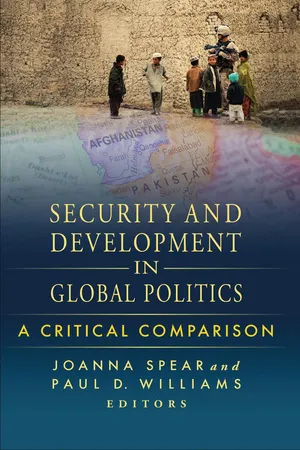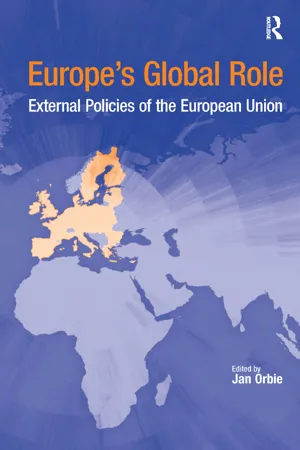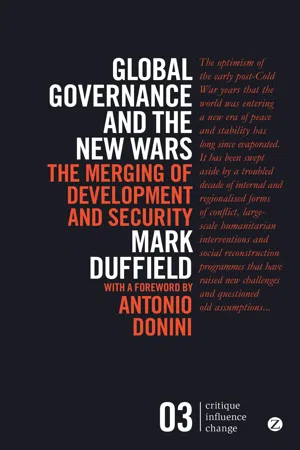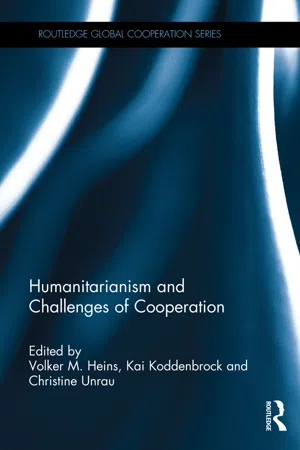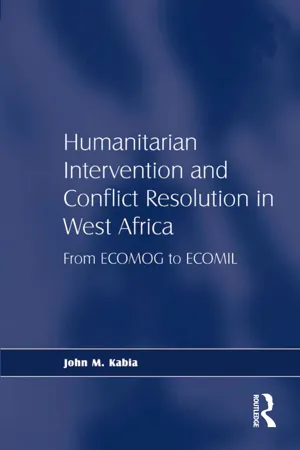Politics & International Relations
Humanitarian Aid
Humanitarian aid refers to the provision of assistance and support to people in need, particularly in the aftermath of natural disasters, conflicts, or other crises. It aims to alleviate suffering, protect human dignity, and save lives by providing essential resources such as food, shelter, medical care, and clean water. Humanitarian aid is often delivered by international organizations, governments, and non-governmental organizations.
Written by Perlego with AI-assistance
Related key terms
7 Key excerpts on "Humanitarian Aid"
- eBook - ePub
Security and Development in Global Politics
A Critical Comparison
- Joanna Spear, Paul D. Williams(Authors)
- 2012(Publication Date)
- Georgetown University Press(Publisher)
Humanitarianism in Question: Politics, Power, Ethics (Ithaca, NY: Cornell University Press, 2008); Fiona Terry, Condemned to Repeat? The Paradox of Humanitarian Action (Ithaca, NY: Cornell University Press, 2002); Jeffrey D. Sachs, The End of Poverty: Economic Possibilities for Our Time (New York: Penguin, 2005); and William Easterly, The White Man’s Burden (New York: Penguin, 2008).14 . See J. Brian Atwood, M. Peter McPherson, and Andrew Natsios, “Arrested Development,” Foreign Affairs 87, no. 6 (2008): 123–32.15 . OECD, “United States (2006) DAC Peer Review: Main Findings and Recommendations,” accessed January 30, 2011, www.oecd.org/document/27/0,3343,en_2649_34603_37829787_1_1_1_1,00.html .16 . See Adele Harmer and Joanna Macrae, eds., “Beyond the Continuum: The Changing Role of Aid Policy in Protracted Crisis” (London: ODI Humanitarian Policy Group Research Report, 2004), www.odi.org.uk/resources/download/236.pdf .HUMANITARIAN ASSISTANCE
Editors’ Comments
Joanna Spear and Paul D. WilliamsAlthough the security and development arenas broadly share a definition of humanitarian assistance, their ideas about what such assistance is for and the problem that it addresses are radically different. The development community conceives the importance of humanitarian assistance purely as a way to save lives and alleviate the suffering of those most in need. Moreover, such assistance is seen as a prior step to effective poverty reduction policies and longer-term development strategies. In contrast, security analysts and practitioners have tended to view humanitarian assistance instrumentally as an element in crafting desirable security outcomes. During the Cold War humanitarian assistance was a way to score points against the Soviets; today it is used to try and curry favor with the Muslim world and enhance counterinsurgency campaigns. - eBook - ePub
Europe's Global Role
External Policies of the European Union
- Jan Orbie(Author)
- 2016(Publication Date)
- Routledge(Publisher)
The Commission explains the commitment to non-political Humanitarian Aid by an appeal to the humanitarian imperative, the entitlement of each human being to emergency aid in times of crisis. A nation must ensure that the humanitarian needs of the population within its borders are met. However, when the government of a country is not capable or willing to take on this responsibility, international organisations and third countries with the necessary resources have the duty to support external Humanitarian Aid operations.The unconditional entitlement to humanitarian relief is in contrast to EU development aid which has become increasingly subject to political conditionality, namely the recipient country’s respect for human rights and democratic principles. For example, while in the spring of 2006 EU foreign ministers decided to suspend aid to the Palestinian Authority controlled by Hamas, this was not to affect Humanitarian Aid for the Palestinian people.The Commission argues that the integration of Humanitarian Aid in a broader political or development-oriented strategy might strain compliance with the humanitarian imperative. If, rather than pursuing the goal of life-saving, Humanitarian Aid is to contribute to conflict resolution and development, this might allow for the creation of deserving and undeserving victims, based on people’s expected contribution to peace-building and development. Such an approach potentially implies withholding aid, which might result in avoidable deaths (De Torrenté 2004, 3; Macrae 2004, 33). For instance, the political imperative to build peace by supporting transitional governments might require marginalising those rebels trying to undermine the transition process, and thus denying humanitarian assistance to those in need who are situated in rebel-controlled areas (Bryer 2003, 5–6).The apolitical character of Humanitarian Aid is also fostered because it is considered to be the main vehicle for safeguarding access to crisis victims and the security of Humanitarian Aid workers. Humanitarians conclude a ‘contract’ with belligerent parties, based on the understanding that assistance comes with no strings attached. This contract has to guarantee the acceptability of humanitarian operations and the immunity of humanitarian staff from attacks. When humanitarians are seen as part of a politico-military strategy, this might undermine their perceived impartiality, and erode their safety and freedom of movement. For example, it has been argued that during the Iraq war, the perception the local population had of some humanitarian organisations as ‘force multipliers’ of US foreign policy and military objectives, put all humanitarian workers in a dangerous position and triggered the deadly attacks on both the UN and Red Cross offices in Baghdad (De Torrenté 2004). - eBook - ePub
Global Governance and the New Wars
The Merging of Development and Security
- Mark Duffield(Author)
- 2014(Publication Date)
- Zed Books(Publisher)
From being a radical aim, humanitarian assistance began to assume the form of a lowest international common denominator in the context of operations that, through experience, were being redefined as long-term and politically complex. In the absence of a clear political resolve to end conflict, humanitarian assistance could even be seen as counter-productive. For example, in providing transport and shelter, aid agencies in Bosnia were often accused of facilitating the very ethnic cleansing they abhorred. In the absence of clear and unequivocal international structures working effectively for peace, the idea of a neutral humanitarianism able to stand above politics became increasingly strained in the seemingly intractable conflicts of the 1990s. In this respect, the strategic complexes of liberal governance do not provide such a system. Liberal peace is a contested and regionally differentiated reality that, through its fluid and changing networks, is capable of marked hierarchies of concern. At the same time, through an exposure to ongoing conflict, aid agencies began to deepen their understanding of the interaction between aid and war and the complexities involved. While external assistance is capable of playing many roles (one should not overestimate the effectiveness of aid in this respect), it was increasingly understood as being far from neutral. Humanitarian assistance, while it could help keep people alive, like any other resource inevitably became part of the local political economy (Duffield 1991 ; Keen 1991) – especially when the new wars have effectively dissolved conventional distinctions between people, army and government. In other words, in today’s network wars the traditional distinctions – ‘military/civilian’, ‘combatant/non-combatant’, etc. – that a neutral humanitarianism ideally would base itself on, no longer properly exist - eBook - ePub
- Volker M. Heins, Kai Koddenbrock, Christine Unrau(Authors)
- 2016(Publication Date)
- Routledge(Publisher)
9 After all, humanitarian budgets are being used to achieve several ends. These vary from responding to acute crises to supporting victims of those continuing for years or even decades. Addressing crises requires support in many forms, such as care and maintenance of refugees, building institutions in fragile states, and disaster prevention, risk reduction, and preparedness. General discussions of humanitarianism(s) and the ethics behind the humanitarian principles are often hindered by the fact that proponents have different humanitarian scenarios in mind. This section introduces a number of these scenarios.Open armed conflicts
Historical commentary on modern humanitarian action usually begins with a reference to the battlefield of Solferino in 1859, where Henry Dunant witnessed heavy and bloody fighting inspiring him to organise medical care, and leading to the formation of the ICRC and the development of International Humanitarian Law. Ironically, humanitarian action is least effective in accessing and assisting affected people in these iconic situations of open, violent conflict. Conflict areas are often inaccessible. When it is too dangerous for aid workers, aid will be withdrawn. Needs in these situations are always vastly larger than aid can cover.The problem of instrumentalisation in these kinds of situations is nothing new. There are, however, some recent developments. Since 9/11 and the proclaimed ‘war on terror’, we are faced with international conflicts in which the so-called international community acts as a ‘neutral outsider’ or as a ‘warring party’ depending on the point of view of the observer. In some conflicts, politicisation and militarisation have indeed led to distrust of humanitarian organisations and the United Nations, as they are frequently associated with Western domination of the international response. The independence of Humanitarian Aid, and hence its credibility, have been severely affected in some countries. - eBook - ePub
The European Union and Humanitarian Crises
Patterns of Intervention
- Francesca Pusterla(Author)
- 2016(Publication Date)
- Routledge(Publisher)
Introduction
Issues in Humanitarian Aid
Over the last few decades, interest in Humanitarian Aid has grown. International organisations, national governments and governmental and private actors have multiplied their efforts to limit and possibly put an end to natural catastrophes, man-made atrocities and political and economic breakdowns affecting civil populations. Consequently, cooperative and unilateral emergency actions have been carried out with the aim of recovering people in need during and after any humanitarian crisis all around the world. Several studies have been conducted addressing questions concerning the definition of humanitarian intervention, the reasons for it, its legitimacy, its goals and the role of actors allocating and receiving aid.1It follows that the evident political attention to Humanitarian Aid allocation also reverberates within academic research on this topic. Accordingly, a particular emphasis has been placed on studies addressing the strategies of foreign aid allocation in a context shared between bilateral aid – where donors finance Humanitarian Aid through the signature of bilateral agreements with recipient countries – and multilateral aid – where donors frame their aid within the institutional context of international organisations. Among the different scientific approaches, such contemporary studies addressing the central issue of bilateral and multilateral aid allocation take on specific relevance for the purpose of this work.Indeed, the analysis of Humanitarian Aid allocation in this study aims at answering the following general research question: how to explain the international actors’ choices between bilateral and multilateral Humanitarian Aid allocation?Specifically, there are two main focuses to the study of bilateral and multilateral aid allocation in need of preliminary clarification. First, relevant studies have been conducted with the aim of underpinning the main differences between bilateral and multilateral aid and disclosing the reasons for states’ preference in favour of the former or the latter. Second, many studies investigate more specifically the realm of multilateral aid allocation. These two approaches delineate the scientific debate into which this work inserts itself and frame the specific angle it takes. - Atsushi Hanatani, Oscar A. Gómez, Chigumi Kawaguchi(Authors)
- 2018(Publication Date)
- Routledge(Publisher)
Another difficult challenge relates to politicization. In humanitarian conflicts, almost all actors—both internal and external—politicize everything, even humanitarian access, for their own tactical and strategic interests and advantages. In the Syrian case, the regime and other armed actors deliberately restrict aid access for political and tactical gain. Consequently, apolitical organizations, such as UN humanitarian agencies and international NGOs, are obliged to operate in a highly politicized environment. Major donors also provide assistance within political contexts, particularly with the goals of facilitating a political transition and state-building. These political objectives may obscure the primary goal of humanitarian relief operations.In this chapter, I first provide an overview of the Syrian civil war and the humanitarian crisis. In the following sections, I explore responses to the crisis inside Syria by UN agencies, major donors (mainly the United States (US), European Union (EU) and United Kingdom (UK)), and their bilateral agencies. I focus particularly on restrictions on humanitarian access, cross-border assistance and remote management, and issues relating to emergency relief assistance and resilience building. Finally, I discuss three issues:- dilemmas between adherence to the humanitarian principles and continuation of aid delivery;
- obstacles caused by the remote management approach; and
- political objectives set by major donors and their impacts on humanitarian relief.
In doing so, I try to explore tensions and dilemmas caused by conflicting relationships between humanitarian relief and politicization. The mass influx of Syrian refugees has had enormous impacts on host countries and communities. However, because the refugee crisis has already been widely discussed, I will not explore refugee issues in this chapter.My study is based on literature research in related fields, plus field research in Lebanon and Jordan in September 2015 and in Turkey in March 2016. During my field research, I conducted 43 semi-structured interviews with officials from UN agencies, government departments, and bilateral agencies, staff of international NGOs, and academics. Corresponding to the time of my field research, this chapter mainly covers the situation until 2016.- eBook - ePub
Humanitarian Intervention and Conflict Resolution in West Africa
From ECOMOG to ECOMIL
- John M. Kabia(Author)
- 2016(Publication Date)
- Routledge(Publisher)
With the proliferation of violent conflicts, the breakdown of state authority and the emergence of militia groups that have no regard for international norms and human rights in Africa and elsewhere, post-Cold War conceptualisation of humanitarian intervention has expanded from its nascent task of protecting victims of human rights abuses by repressive regimes in foreign countries to providing security to threatened populations caught up in the complex political emergencies (CPEs) that have come to characterise the end of the Cold War. It has also expanded to include non-forcible tasks such as the distribution of emergency relief to ameliorate the suffering of victims, securing the humanitarian space necessary for effective operations of aid agencies, and facilitating conflict resolution and post-war peacebuilding to prevent a relapse into conflict. These expanded roles and expectations have however placed serious difficulties on the part of interveners as the cases of Somalia, Rwanda and Bosnia demonstrate.This chapter seeks to conceptualise humanitarian intervention in the post-Cold War era and examine the challenges it faces in today’s complex political emergencies and post 9/11 era. It argues in favour of the solidarist approach to humanitarian intervention and posits that the challenges posed by CPEs warrants the broadening of its remits to include both forcible and non-forcible strategies aimed at safeguarding civilians in the short term and building sustainable peace in the medium to long term. Starting with a working definition of the concept, we then trace the origin and evolution of humanitarian intervention. Next, a detailed analysis of complex political emergencies will be used to understand the challenges and difficulties facing interveners and form the basis for a reframing of the debate on humanitarian intervention in light of current realities. The next section will develop a framework for analysis in the entire book which will be followed by definition of terms and concepts.Humanitarian Intervention: A Working Definition
Wil Verwey (1992, 114) provided what is now considered a classic definition of humanitarian intervention,the threat or use of force by a state or states abroad, for the sole purpose of preventing or putting a halt to a serious violation of fundamental human rights, in particular the right to life of persons, regardless of their nationality, such protection taking place neither upon authorisation by relevant organs of United Nations nor with permission by the legitimate government of the target state.Like other restrictionists’ view of the term, Verwey stressed that the motive of humanitarian intervention should be ‘solely’ humanitarian. This strict stipulation disqualifies any intervention as ‘humanitarian’ considering the political interests and processes that are also certain to be involved in practice. Solidarists like Wheeler (2000) and Teson (2003) object to this strict emphasis on motive as they argue that this approach ‘takes the intervening state as referent object for analysis rather than the victims who are rescued as a consequence of the use of force’ (Wheeler, 2000, 38). This however leads us to two very controversial debates within humanitarianism: what counts as humanitarian and the question of the universality of human rights. Despite the frequent use of the term, ‘a consistent and working definition of humanitarianism has evaded public and private authorities’ (Nicholls, 1987, 193). This has prompted Adam Roberts to ask ‘What on earth does humanitarian mean?’ (Roberts, 1993, 13). Ephraim Isaac defines humanitarianism as ‘a feeling of concern for and benevolence toward fellow human beings. It is a universal phenomenon manifested globally and through out the ages’ (Isaac, 1993, 13). Ramsbotham and Woodhouse (1996) link humanitarianism with international humanitarian law of armed conflict, international human rights law and emergency aid. But what level of humanitarian suffering requires outside intervention? Solidarists like Wheeler refer to a ‘supreme humanitarian emergency’ to describe a situation of extreme human suffering wherein ‘the only hope of saving lives depends on outsiders coming to the rescue’ (Wheeler, 2000, 34). However he admits there are no objective criteria for determining what counts as a ‘supreme humanitarian emergency’. This work will define humanitarian emergency to mean a situation of excessive violation of human rights by a repressive government or cases of uncontrolled anarchy and mass murder caused by conflict and/or state collapse.
Learn about this page
Index pages curate the most relevant extracts from our library of academic textbooks. They’ve been created using an in-house natural language model (NLM), each adding context and meaning to key research topics.
